Hydrogen Storage Potential in Natural Gas Deposits in the Polish Lowlands
Abstract
1. Introduction
1.1. Hydrogen Storage in Natural Gas Deposits
1.2. Assessment of Hydrogen Storage Capacity in Geological Structures
1.3. Purpose of Research
2. Materials and Methods
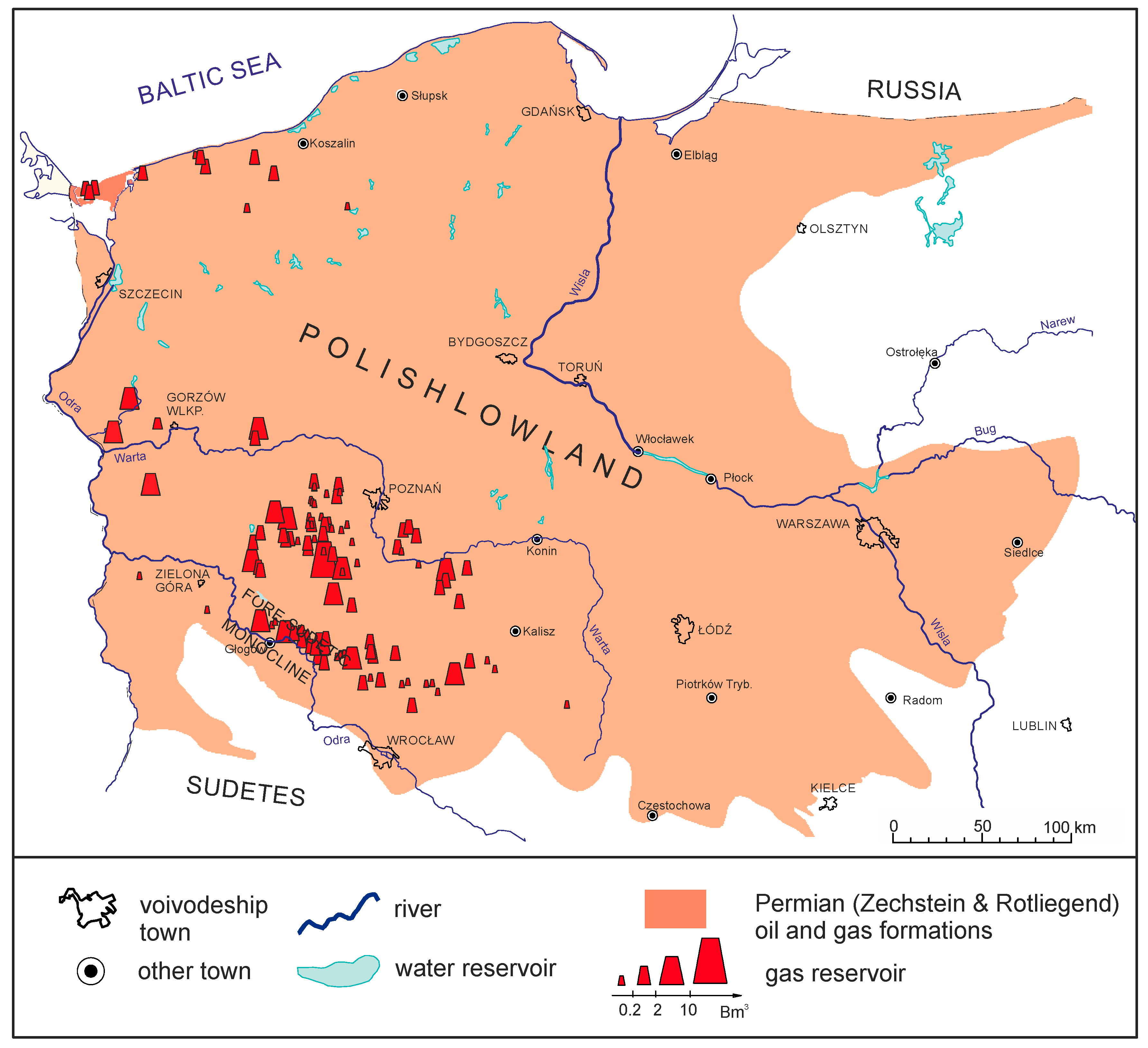
- RG denotes the original exploitable resources (mld m3);
- GEF denotes the gas expansion factor;
- denotes hydrogen density in the reservoir condition (kg/m3).
- P denotes pressure;
- R denotes the gas constant 4160 J/kg·K for hydrogen [60];
- T denotes temperature;
- b denotes the covolume 15.84 cm3/mol for hydrogen [61].
3. Results and Discussion
4. Conclusions
Author Contributions
Funding
Data Availability Statement
Conflicts of Interest
References
- COM/2019/640. Communication from the Commission—The European Green Deal. 2019. Available online: https://eur-lex.europa.eu/legal-content/EN/TXT/?uri=COM%3A2019%3A640%3AFIN (accessed on 1 December 2023).
- Council of the EU and the European Council Fit for 55—The EU’s Plan for a Green Transition—Consilium. Available online: https://www.consilium.europa.eu/en/policies/green-deal/fit-for-55-the-eu-plan-for-a-green-transition/ (accessed on 13 November 2023).
- COM/2020/301. Communication from the Commission to the European Parliament, the Council, the European Economic and Social Committee and the Committee of the Regions: A Hydrogen Strategy for a Climate-Neutral Europe. 2020. Available online: https://eur-lex.europa.eu/legal-content/EN/TXT/?uri=CELEX%3A52020DC0301 (accessed on 1 December 2023).
- Energy policy of Poland. In Energy Policy of Poland until 2040; Ministry of Climate and Environment: Warsaw, Poland, 2021.
- PHE. Polish Hydrogen Strategy until 2030 with an Outlook until 2040; PHE: Warsaw, Poland, 2021.
- Uliasz-Misiak, B.; Lewandowska-Śmierzchalska, J.; Matuła, R.; Tarkowski, R. Prospects for the Implementation of Underground Hydrogen Storage in the EU. Energies 2022, 15, 9535. [Google Scholar] [CrossRef]
- Tarkowski, R.; Uliasz-Misiak, B. Towards Underground Hydrogen Storage: A Review of Barriers. Renew. Sustain. Energy Rev. 2022, 162, 112451. [Google Scholar] [CrossRef]
- Kruck, O.; Crotogino, F.; Prelicz, R.; Rudolph, T. A Overview on All Known Underground Storage Technologies for Hydrogen. 2013. Available online: https://hyunder.eu/wp-content/uploads/2016/01/D3.1_Overview-of-all-known-underground-storage-technologies.pdf (accessed on 1 December 2023).
- Panfilov, M. Underground and Pipeline Hydrogen Storage. In Compendium of Hydrogen Energy; Elsevier: Amsterdam, The Netherlands, 2016; Volume 2, pp. 91–115. [Google Scholar]
- Ponomarev-Stepnoy, N.N.; Stolyarevsky, A.Y. Major Aspects of Strategy of Hydrogen-Base Power Development with Nuclear Energy Sources. In Proceedings of the International Conference on Fifty Years of Nuclear Power—The Next Fifty Years; International Atomic Energy Agency: Vienna, Austria, 2004. [Google Scholar]
- Zivar, D.; Kumar, S.; Foroozesh, J. Underground Hydrogen Storage: A Comprehensive Review. Int. J. Hydrogen Energy 2021, 46, 23436–23462. [Google Scholar] [CrossRef]
- Khilyuk, L.F.; Chilingar, G.V.; Robertson, J.O.; Endres, B. Hazards of Gas Storage Fields. Gas Migr. 2000, 290–305. [Google Scholar] [CrossRef]
- Wallace, R.L.; Cai, Z.; Zhang, H.; Zhang, K.; Guo, C. Utility-Scale Subsurface Hydrogen Storage: UK Perspectives and Technology. Int. J. Hydrogen Energy 2021, 49, 25137–25159. [Google Scholar] [CrossRef]
- Chen, F.; Ma, Z.; Nasrabadi, H.; Chen, B.; Saad Mehana, M.Z.; Van Wijk, J. Capacity Assessment and Cost Analysis of Geologic Storage of Hydrogen: A Case Study in Intermountain-West Region USA. Int. J. Hydrogen Energy 2023, 48, 9008–9022. [Google Scholar] [CrossRef]
- Wei, L.; Jie, C.; Deyi, J.; Xilin, S.; Yinping, L.; Daemen, J.J.K.; Chunhe, Y. Tightness and Suitability Evaluation of Abandoned Salt Caverns Served as Hydrocarbon Energies Storage under Adverse Geological Conditions (AGC). Appl. Energy 2016, 178, 703–720. [Google Scholar] [CrossRef]
- Lord, A.S. Overview of Geologic Storage of Natural Gas with an Emphasis on Assessing the Feasibility of Storing Hydrogen; Albuquerque, NM, USA, 2009. Available online: https://www.osti.gov/servlets/purl/975258 (accessed on 1 December 2023).
- Lysyy, M.; Fernø, M.; Ersland, G. Seasonal Hydrogen Storage in a Depleted Oil and Gas Field. Int. J. Hydrogen Energy 2021, 49, 25160–25174. [Google Scholar] [CrossRef]
- Muhammed, N.S.; Haq, B.; Abdullah, D.; Shehri, A.; Al-Ahmed, A.; Rahman, M.M.; Zaman, E.; Iglauer, S. Hydrogen Storage in Depleted Gas Reservoirs: A Comprehensive Review. Fuel 2022, 337, 127032. [Google Scholar] [CrossRef]
- Hollis, A.P. Some Petroleum Engineering Considerations in the Changeover of the Rough Gas Field to the Storage Mode. J. Pet. Technol. 1984, 36, 797–804. [Google Scholar] [CrossRef]
- Feldmann, F.; Hagemann, B.; Ganzer, L.; Panfilov, M. Numerical Simulation of Hydrodynamic and Gas Mixing Processes in Underground Hydrogen Storages. Environ. Earth Sci. 2016, 75, 1165. [Google Scholar] [CrossRef]
- Muhammed, N.S.; Haq, B.; Al Shehri, D.; Al-Ahmed, A.; Rahman, M.M.; Zaman, E. A Review on Underground Hydrogen Storage: Insight into Geological Sites, Influencing Factors and Future Outlook. Energy Rep. 2022, 8, 461–499. [Google Scholar] [CrossRef]
- Katz, D.L.; Tek, M.R. Overview on Underground Storage of Natural Gas. J. Pet. Technol. 1981, 33, 943–951. [Google Scholar] [CrossRef]
- Luboń, K.; Tarkowski, R. Numerical Simulation of Hydrogen Injection and Withdrawal to and from a Deep Aquifer in NW Poland. Int. J. Hydrogen Energy 2020, 45, 2068–2083. [Google Scholar] [CrossRef]
- Sainz-Garcia, A.; Abarca, E.; Rubi, V.; Grandia, F. Assessment of Feasible Strategies for Seasonal Underground Hydrogen Storage in a Saline Aquifer. Int. J. Hydrogen Energy 2017, 42, 16657–16666. [Google Scholar] [CrossRef]
- Amid, A.; Mignard, D.; Wilkinson, M. Seasonal Storage of Hydrogen in a Depleted Natural Gas Reservoir. Int. J. Hydrogen Energy 2016, 41, 5549–5558. [Google Scholar] [CrossRef]
- Kanaani, M.; Sedaee, B.; Asadian-Pakfar, M. Role of Cushion Gas on Underground Hydrogen Storage in Depleted Oil Reservoirs. J. Energy Storage 2022, 45, 103783. [Google Scholar] [CrossRef]
- Lord, A.S.; Kobos, P.H.; Borns, D.J. Geologic Storage of Hydrogen: Scaling up to Meet City Transportation Demands. Int. J. Hydrogen Energy 2014, 39, 15570–15582. [Google Scholar] [CrossRef]
- Zhang, T.; Zhang, Y.; Katterbauer, K.; Al Shehri, A.; Sun, S.; Hoteit, I. Phase Equilibrium in the Hydrogen Energy Chain. Fuel 2022, 328, 125324. [Google Scholar] [CrossRef]
- Zhang, T.; Zhang, Y.; Katterbauer, K.; Al Shehri, A.; Sun, S.; Hoteit, I. Deep Learning–Assisted Phase Equilibrium Analysis for Producing Natural Hydrogen. Int. J. Hydrogen Energy 2024, 50, 473–486. [Google Scholar] [CrossRef]
- Lankof, L.; Tarkowski, R. Assessment of the Potential for Underground Hydrogen Storage in Bedded Salt Formation. Int. J. Hydrogen Energy 2020, 45, 19479–19492. [Google Scholar] [CrossRef]
- Caglayan, D.G.; Weber, N.; Heinrichs, H.U.; Linßen, J.; Robinius, M.; Kukla, P.A.; Stolten, D. Technical Potential of Salt Caverns for Hydrogen Storage in Europe. Int. J. Hydrogen Energy 2020, 45, 6793–6805. [Google Scholar] [CrossRef]
- Lankof, L.; Urbańczyk, K.; Tarkowski, R. Assessment of the Potential for Underground Hydrogen Storage in Salt Domes. Renew. Sustain. Energy Rev. 2022, 160, 112309. [Google Scholar] [CrossRef]
- Aftab, A.; Hassanpouryouzband, A.; Naderi, H.; Xie, Q.; Sarmadivaleh, M. Quantifying Onshore Salt Deposits and Their Potential for Hydrogen Energy Storage in Australia. J. Energy Storage 2023, 65, 107252. [Google Scholar] [CrossRef]
- Bradshaw, M.; Rees, S.; Wang, L.; Szczepaniak, M.; Cook, W.; Voegeli, S.; Boreham, C.; Wainman, C.; Wong, S.; Southby, C.; et al. Australian Salt Basins—Options for Underground Hydrogen Storage. APPEA J. 2023, 63, 285–304. [Google Scholar] [CrossRef]
- Hui, S.; Yin, S.; Pang, X.; Chen, Z.; Shi, K. Potential of Salt Caverns for Hydrogen Storage in Southern Ontario, Canada. Mining 2023, 3, 399–408. [Google Scholar] [CrossRef]
- Cavanagh, A.J.; Yousefi, S.H.; Wilkinson, M.; Groenenberg, R.M. Hydrogen Storage Potential of Existing European Gas Storage Sites in Depleted Gas Fields and Aquifers; HyUSPRe: Los Angeles, CA, USA, 2022. [Google Scholar]
- Barison, E.; Donda, F.; Merson, B.; Le Gallo, Y.; Réveillère, A. An Insight into Underground Hydrogen Storage in Italy. Sustainability 2023, 15, 6886. [Google Scholar] [CrossRef]
- Alms, K.; Ahrens, B.; Graf, M.; Nehler, M. Linking Geological and Infrastructural Requirements for Large-Scale Underground Hydrogen Storage in Germany. Front. Energy Res. 2023, 11, 1172003. [Google Scholar] [CrossRef]
- English, J.M.; English, K.L. Overview of Hydrogen and Geostorage Potential in Ireland. First Break 2023, 41, 41–49. [Google Scholar] [CrossRef]
- RISC. Hydrogen Storage Potential of Depleted Oil and Gas Fields in Western Australia Literature Review and Scoping Study; Geological Survey of Western Australia: Cascade, Australia, 2021.
- Okoroafor, E.R.; Kim, T.W.; Nazari, N.; Watkins, H.Y.; Saltzer, S.D.; Kovscek, A.R. Assessing the Underground Hydrogen Storage Potential of Depleted Gas Fields in Northern California. In Proceedings of the SPE Annual Technical Conference and Exhibition, Houston, TX, USA, 3–5 October 2022. [Google Scholar] [CrossRef]
- Lackey, G.; Freeman, G.M.; Buscheck, T.A.; Haeri, F.; White, J.A.; Huerta, N.; Goodman, A. Characterizing Hydrogen Storage Potential in U.S. Underground Gas Storage Facilities. Geophys. Res. Lett. 2023, 50, e2022GL101420. [Google Scholar] [CrossRef]
- Scafidi, J.; Wilkinson, M.; Gilfillan, S.M.V.; Heinemann, N.; Haszeldine, R.S. A Quantitative Assessment of the Hydrogen Storage Capacity of the UK Continental Shelf. Int. J. Hydrogen Energy 2021, 46, 8629–8639. [Google Scholar] [CrossRef]
- Emmel, B.; Bjørkvik, B.; Frøyen, T.L.; Cerasi, P.; Stroisz, A. Evaluating the Hydrogen Storage Potential of Shut down Oil and Gas Fields along the Norwegian Continental Shelf. Int. J. Hydrogen Energy 2023, 48, 24385–24400. [Google Scholar] [CrossRef]
- Ventisky, E.; Gilfillan, S.M.V. Assessment of the Onshore Storage Capacity of Hydrogen in Natural Gas Fields in Argentina. Geoenergy 2023, 18, 2023. [Google Scholar] [CrossRef]
- Qiu, Y.; Zhou, S.; Wang, J.; Chou, J.; Fang, Y.; Pan, G.; Gu, W. Feasibility Analysis of Utilising Underground Hydrogen Storage Facilities in Integrated Energy System: Case Studies in China. Appl. Energy 2020, 269, 115140. [Google Scholar] [CrossRef]
- Ślizowski, J.; Urbańczyk, K.; Łaciak, M.; Lankof, L.; Serbin, K. Effectiveness of Natural Gas and Hydrogen Storage in Salt Caverns. Przemysł Chem. 2017, 96, 60–64. [Google Scholar] [CrossRef]
- Luboń, K.T.; Tarkowski, R. Numerical Simulation of Hydrogen Storage in the Konary Deep Saline Aquifer Trap. Gospod. Surowcami Miner. 2023, 39, 103–124. [Google Scholar] [CrossRef]
- Bouteldja, M.; Le Gallo, Y. From Hydrogen Storage Potential to Hydrogen Capacities in Underground Hydrogen Storages; European Association of Geoscientists & Engineers: Utrecht, The Netherlands, 2023; Volume 2023, pp. 1–5. [Google Scholar] [CrossRef]
- Hassanpouryouzband, A.; Joonaki, E.; Edlmann, K.; Haszeldine, R.S. Offshore Geological Storage of Hydrogen: Is This Our Best Option to Achieve Net-Zero? ACS Energy Lett. 2021, 6, 2181–2186. [Google Scholar] [CrossRef]
- Mouli-Castillo, J.; Heinemann, N.; Edlmann, K. Mapping Geological Hydrogen Storage Capacity and Regional Heating Demands: An Applied UK Case Study. Appl. Energy 2021, 283, 116348. [Google Scholar] [CrossRef]
- Szamałek, K.; Szuflicki, M.; Mizerski, W. (Eds.) Bilans Perspektywicznych Zasobów Kopalin Polski; Państwowy Instytut Geologiczny—PIB: Warsaw, Poland, 2020.
- Wójcik, K.; Zacharski, J.; Łojek, M.; Wróblewska, S.; Kiersnowski, H.; Wa’skiewiczwa’skiewicz, K.; Wójcicki, A.; Laskowicz, R.; Sobié, K.; Peryt, T.; et al. New Opportunities for Oil and Gas Exploration in Poland-A Review. Energies 2022, 15, 1739. [Google Scholar] [CrossRef]
- Mazurek, S.; Tymiński, M.; Malon, A.; Szuflicki, M. (Eds.) Mineral Resources of Poland, 6th ed.; Polish Geological Institute—National Research Institute: Warsaw, Poland, 2022.
- MIDAS PIG-PIB. Available online: http://geoportal.pgi.gov.pl/portal/page/portal/midas (accessed on 13 November 2023).
- Jurga, B.; Kiersnowski, H.; Sidorczuk, M.; Pachytel, R. Crude Oil, Natural Gas—Mineral Resources of Poland as Seen by Polish Geological Survey; Polish Geological Institute: Warsaw, Poland, 2020.
- Uliasz-Misiak, B. CO2 Storage Capacity Classification and Site Selection Criteria. Gospod. Surowcami Miner. Miner. Resour. Manag. 2009, 25, 97–108. [Google Scholar]
- Holloway, S.; Rochelle, C.; Bateman, K.; Pearce, J.; Baily, H.; Metcalfe, R. The Underground Disposal of Carbon Dioxide: Final Report; Holloway, S., Ed.; British Geological Survey: Nottingham, UK, 1996.
- Johnston, I.A. The Noble-Abel Equation of State: Thermodynamic Derivations for Ballistics Modelling; Defence Science and Technology Organisation Edinburgh (Australia) Weapons Systems Div: Edinburgh, Australia, 2005.
- Bolton, W. Engineering Science, 7th ed.; Routledge: London, UK, 2020; ISBN 9780367554453. [Google Scholar]
- San Marchi, C.; Somerday, B.P. Thermodynamics of Gaseous Hydrogen and Hydrogen Transport in Metals. In Proceedings of the MRS Online Proceedings Library (OPL), Volume 1098: Symposium HH—The Hydrogen Economy; Cambridge University Press: Cambridge, UK, 2008; Volume 1098. [Google Scholar]
- H2data.de. H2data.de—Hydrogen Fact Sheet. Available online: http://www.h2data.de/ (accessed on 10 November 2023).
- Hystories Hydrogen Storage Resource for Depleted Fields and Aquifers in Europe. Available online: https://hystories.eu/hydrogen-storage-resource-for-depleted-fields-and-aquifers-in-europe/ (accessed on 10 November 2023).

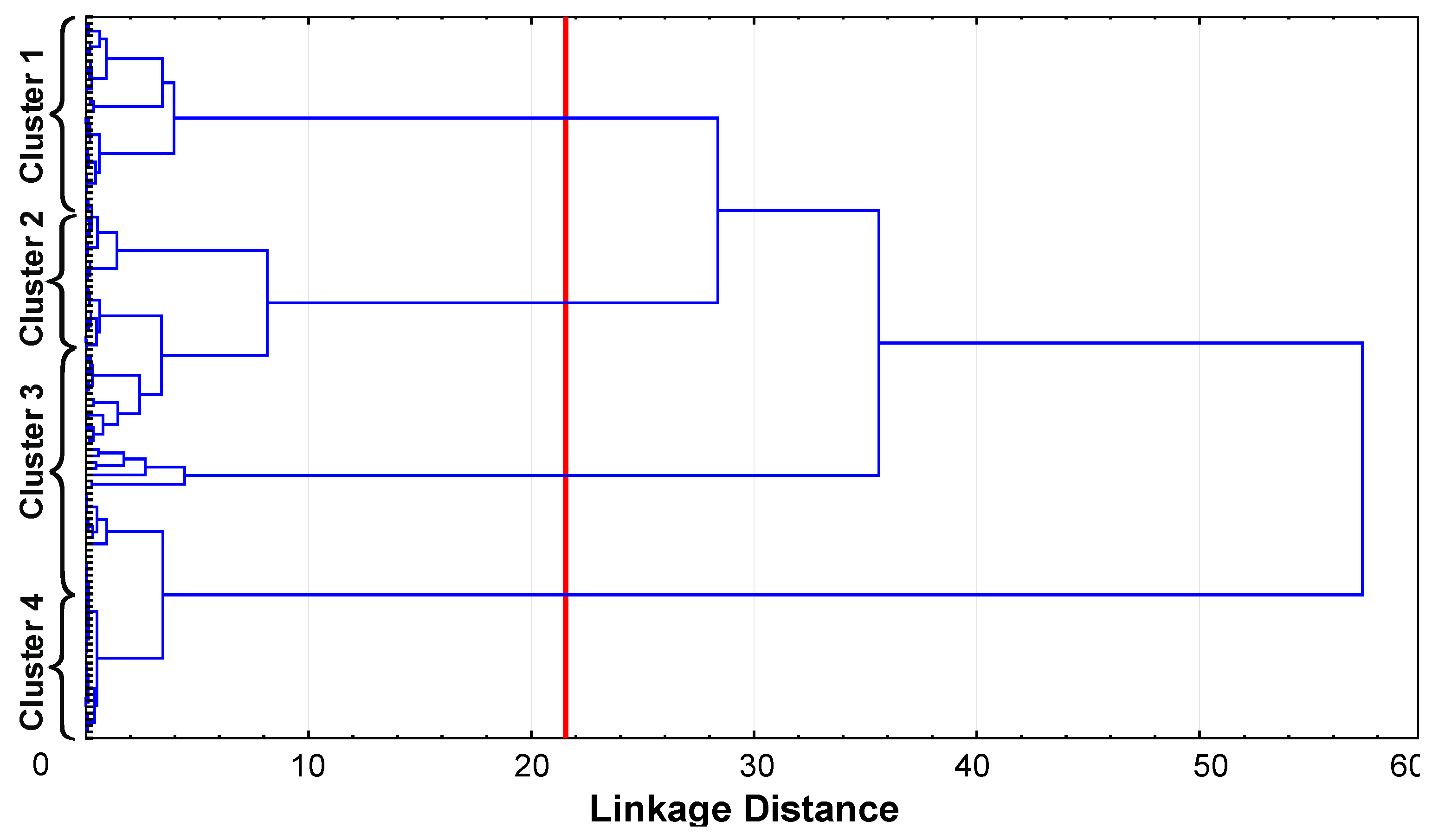
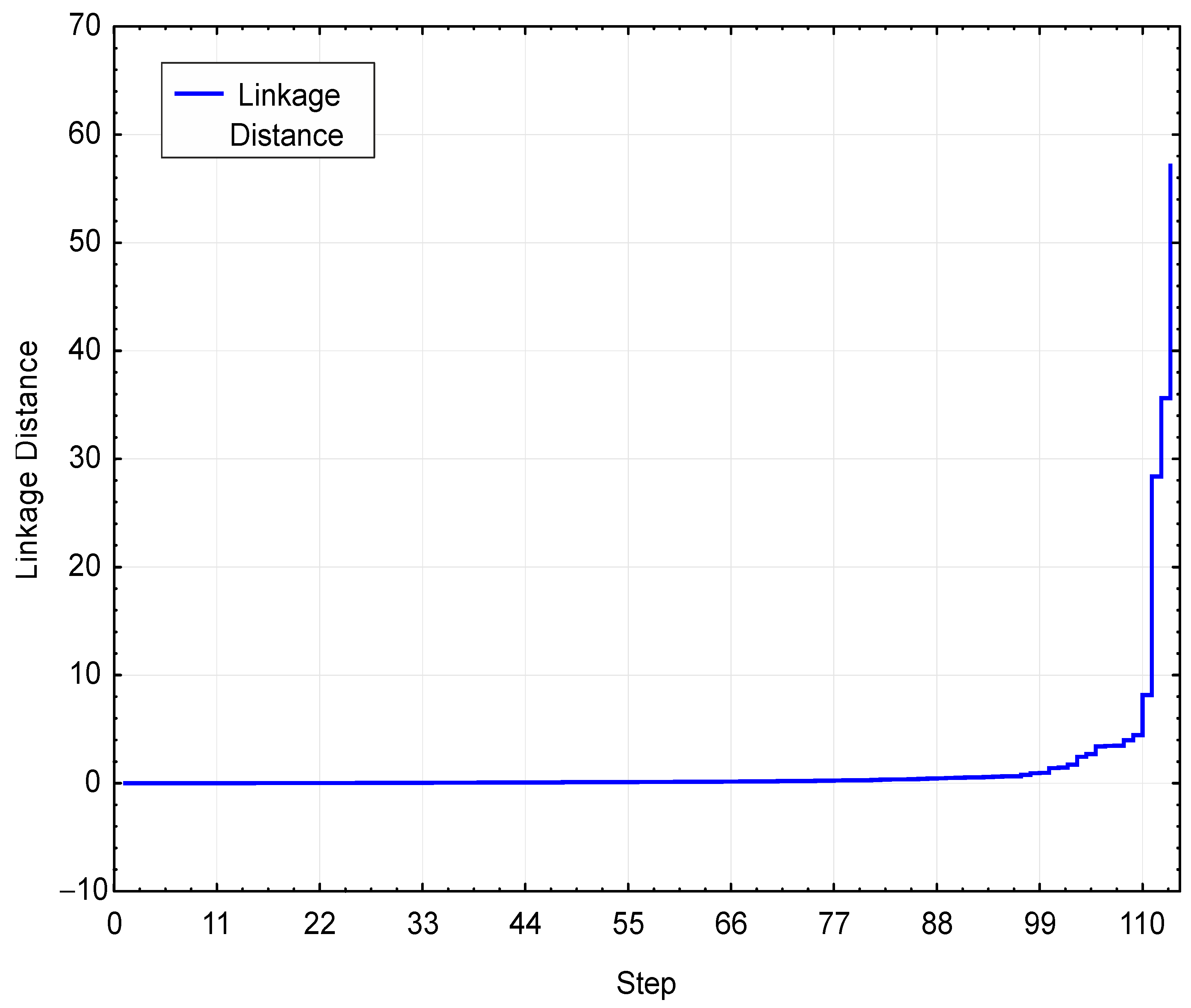
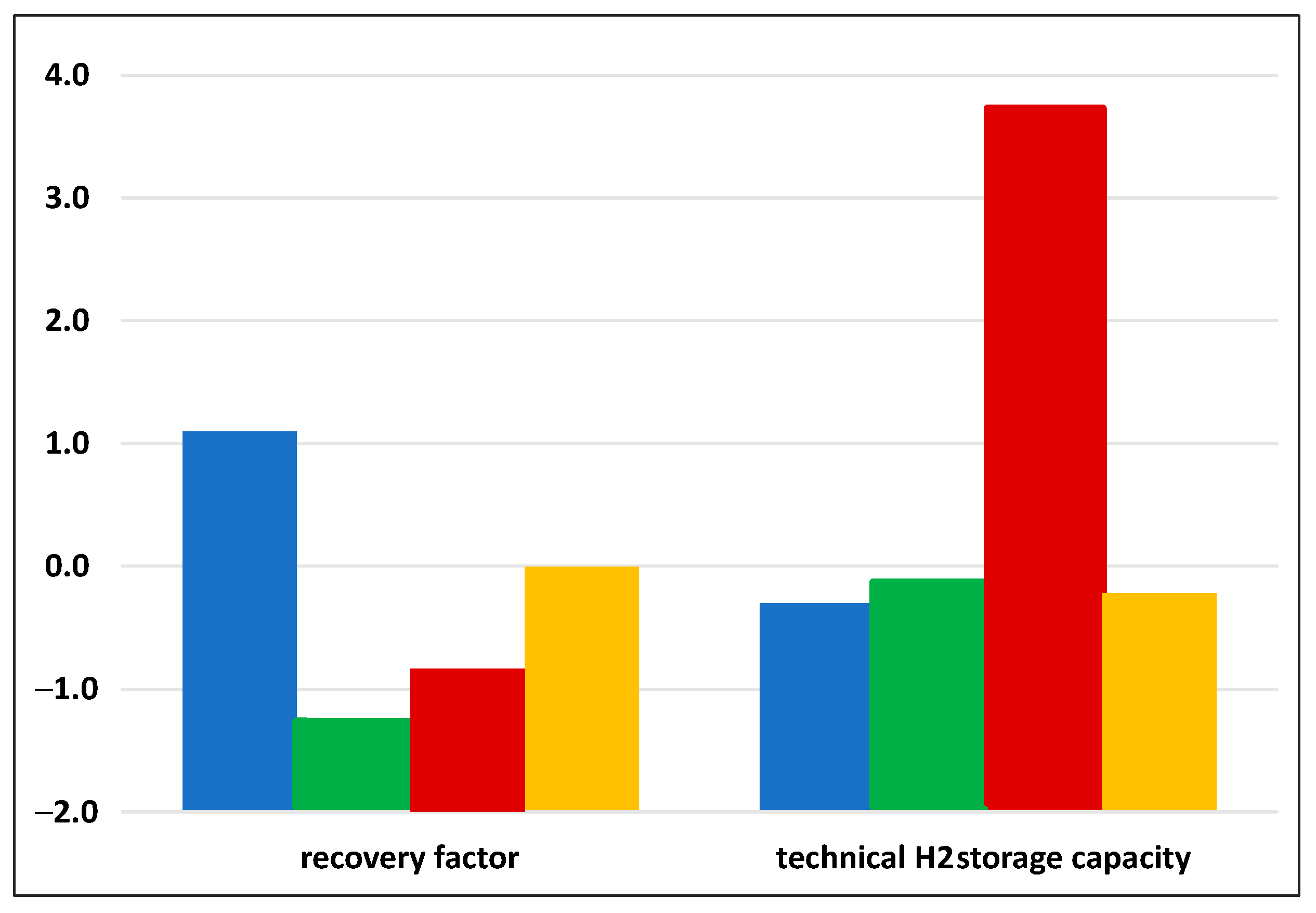

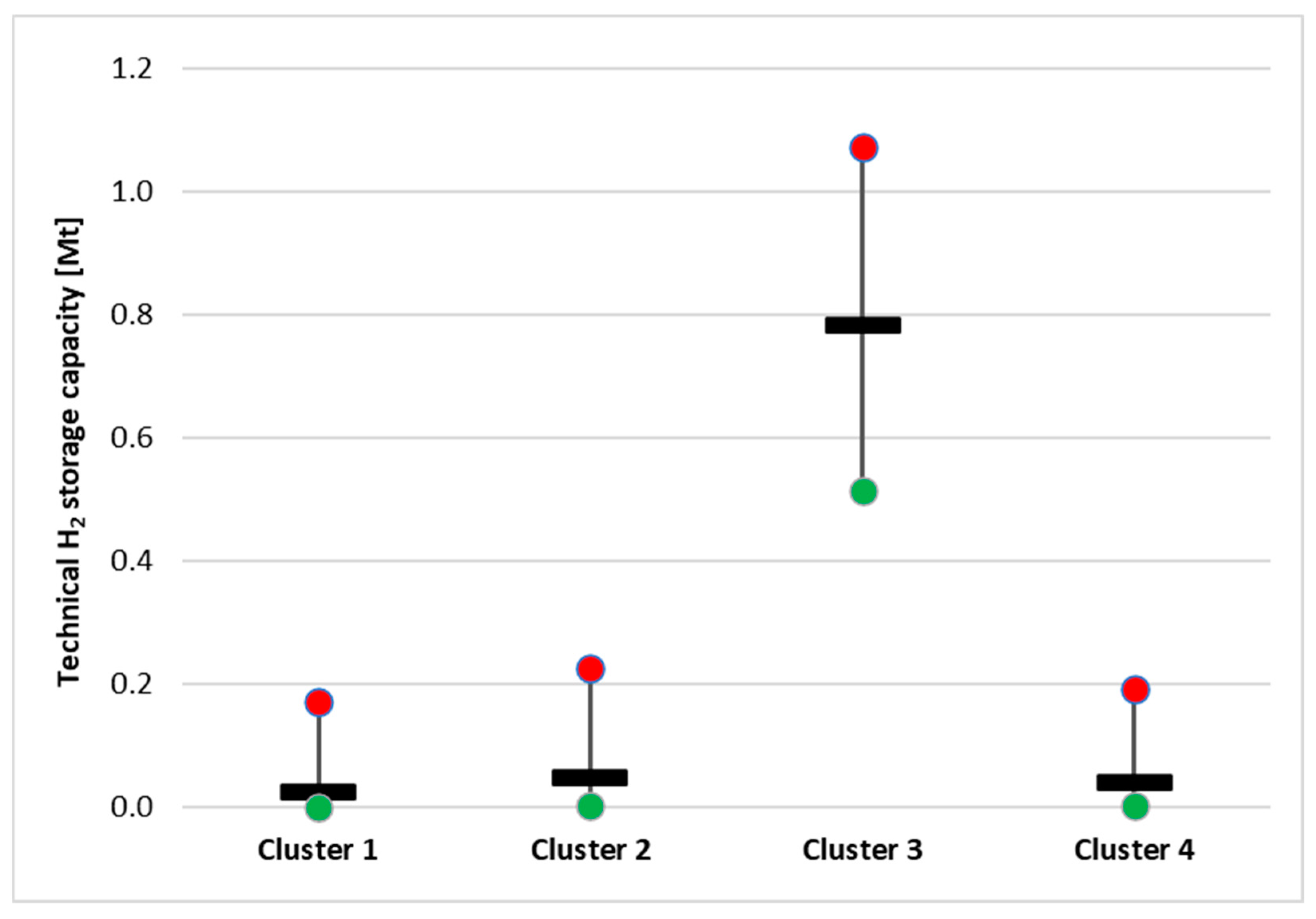
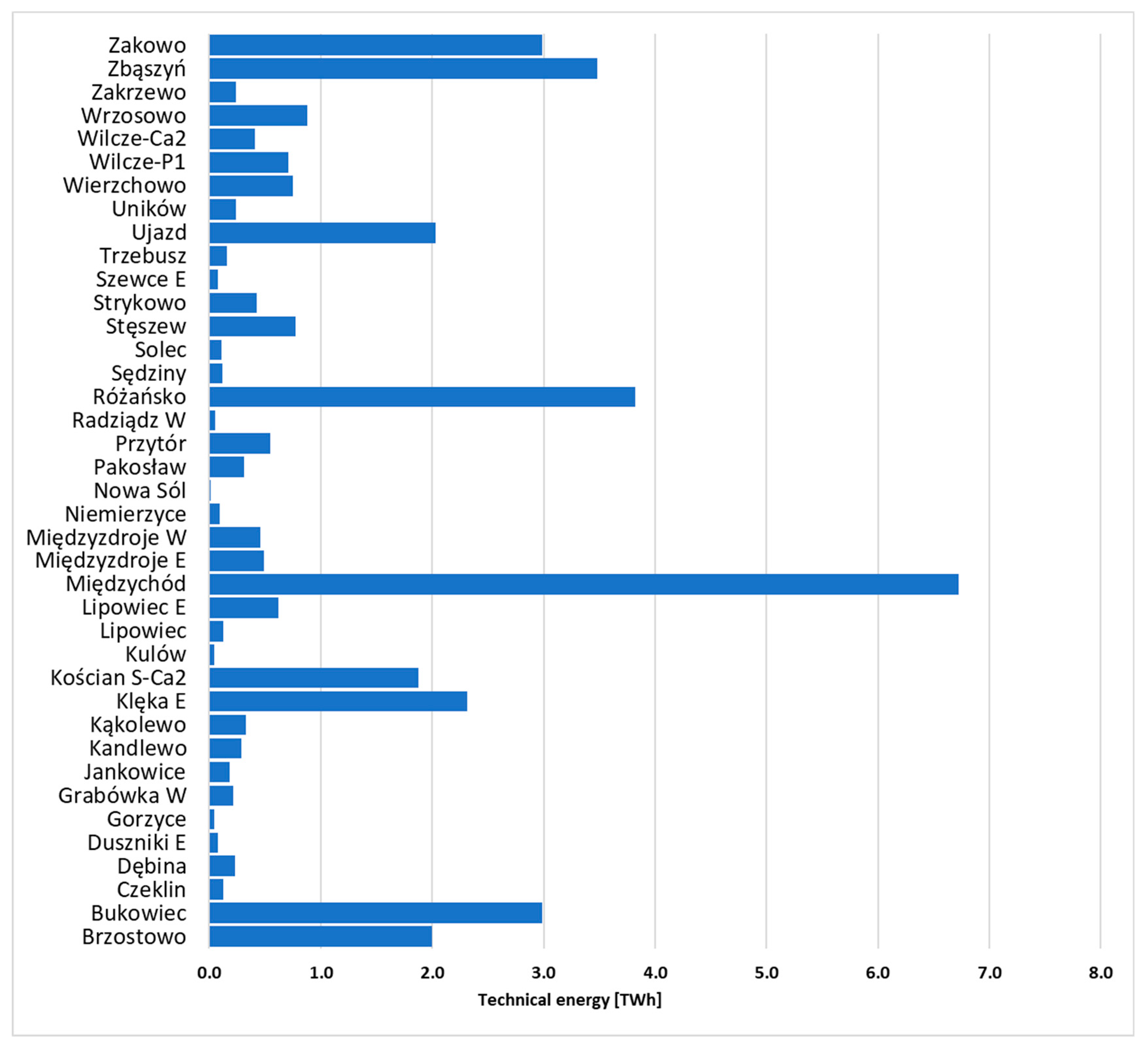
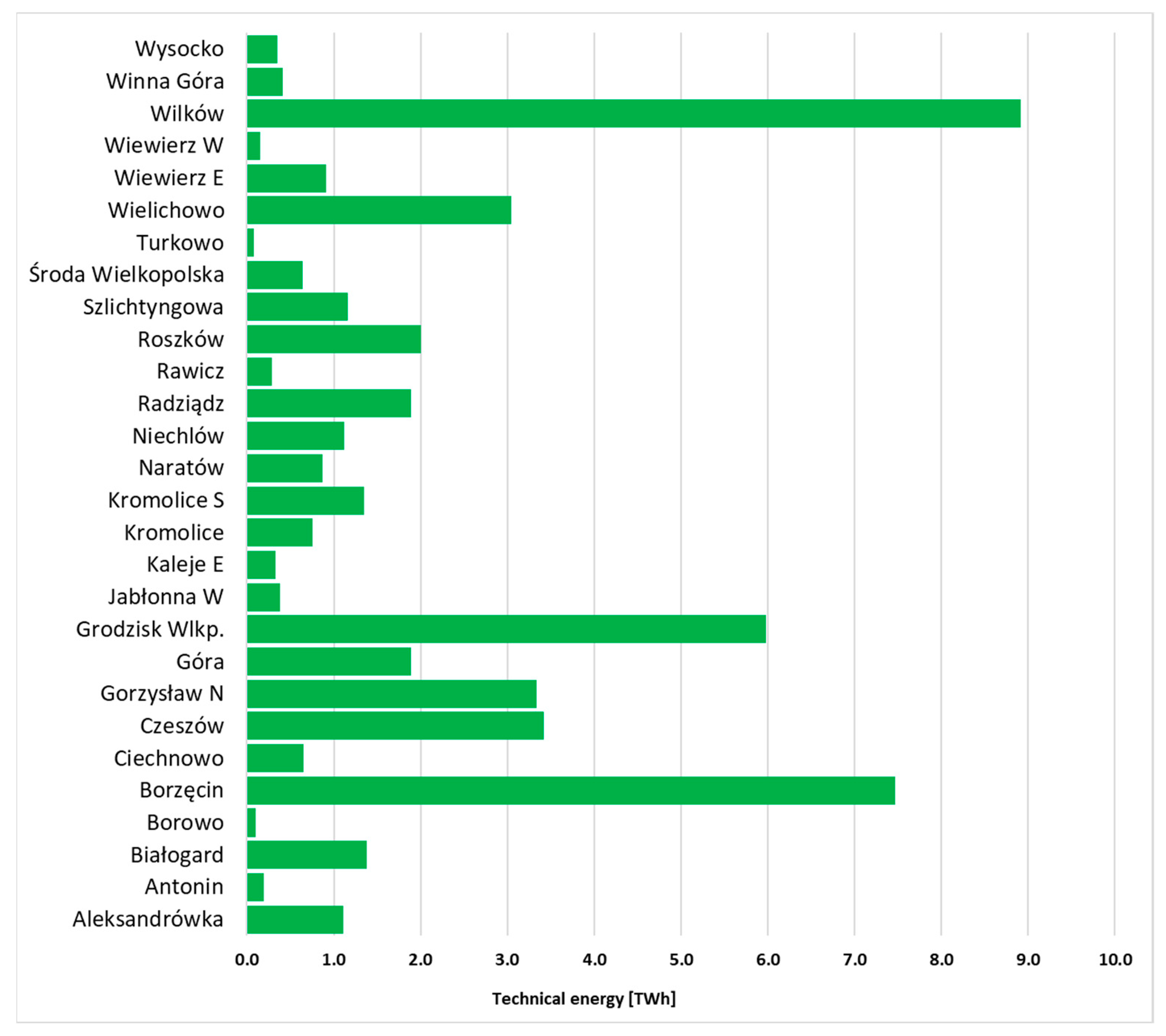
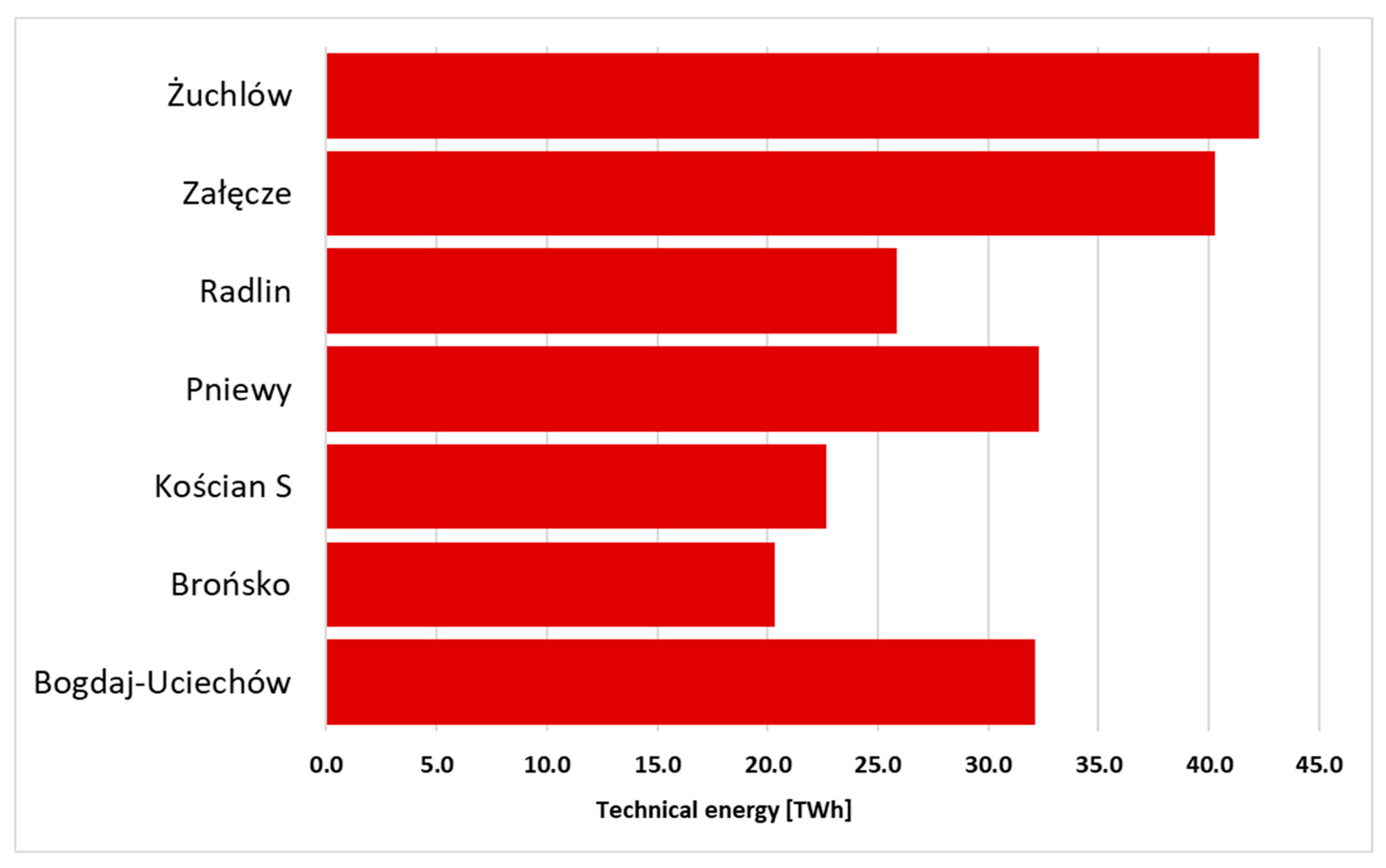
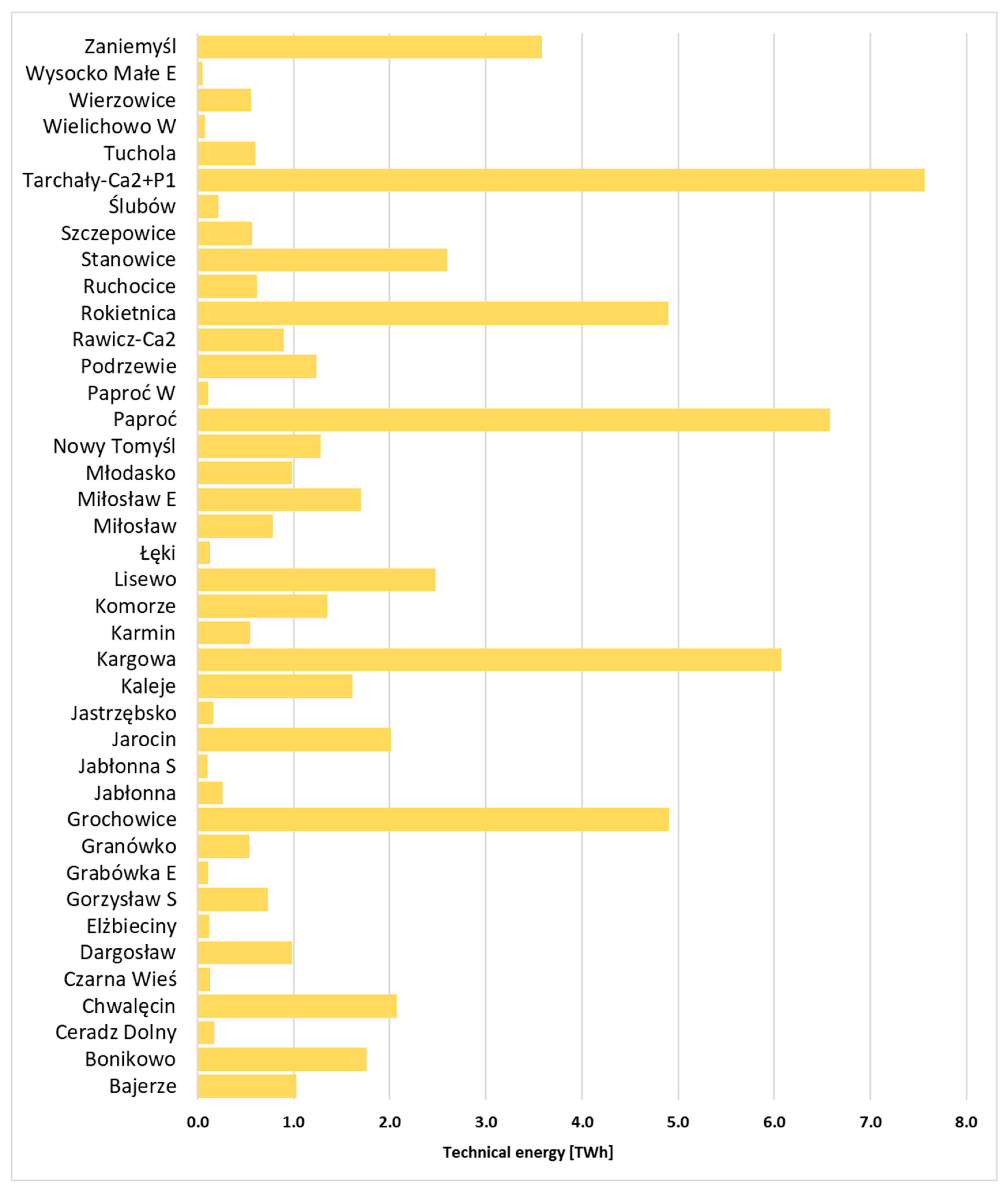
| Parameters | Resources (mln m3) | Depth (m) | Pressure (MPa) | Temperature (°K) | Recovery Factor (%) |
|---|---|---|---|---|---|
| Mean value | 600.78 | 2387.82 | 26.68 | 357.88 | 58.54 |
| Median value | 213.97 | 2454.50 | 27.52 | 362.50 | 59.22 |
| Standard deviation | 1414.38 | 794.43 | 9.62 | 26.13 | 36.79 |
| Kurtosis | 47.37 | −1.18 | −0.20 | −1.02 | −1.44 |
| Skewness | 6.14 | −0.01 | 0.35 | −0.04 | −0.25 |
| Minimum value | 1.26 | 1030.00 | 9.56 | 310.00 | 0.00 |
| Maximum value | 12,617.74 | 4008.50 | 55.00 | 409.37 | 100.00 |
| Mean value | 600.78 | 2387.82 | 26.68 | 357.88 | 58.54 |
| Parameters | Theoretical H2 Storage Capacity (Mt) | Theoretical H2 Energy Equivalent (TWh) | Technical H2 Storage Capacity (Mt) | Technical H2 Energy Equivalent (TWh) |
|---|---|---|---|---|
| Mean value | 0.11 | 4.49 | 0.08 | 3.21 |
| Median value | 0.03 | 1.17 | 0.02 | 0.74 |
| Standard deviation | 0.25 | 9.89 | 0.19 | 7.57 |
| Kurtosis | 12.32 | 12.32 | 14.30 | 14.30 |
| Skewness | 3.54 | 3.54 | 3.77 | 3.77 |
| Minimum value | 0.00 | 0.02 | 0.00 | 0.01 |
| Maximum value | 1.34 | 52.82 | 1.07 | 42.26 |
| Mean value | 0.11 | 4.49 | 0.08 | 3.21 |
Disclaimer/Publisher’s Note: The statements, opinions and data contained in all publications are solely those of the individual author(s) and contributor(s) and not of MDPI and/or the editor(s). MDPI and/or the editor(s) disclaim responsibility for any injury to people or property resulting from any ideas, methods, instructions or products referred to in the content. |
© 2024 by the authors. Licensee MDPI, Basel, Switzerland. This article is an open access article distributed under the terms and conditions of the Creative Commons Attribution (CC BY) license (https://creativecommons.org/licenses/by/4.0/).
Share and Cite
Uliasz-Misiak, B.; Lewandowska-Śmierzchalska, J.; Matuła, R. Hydrogen Storage Potential in Natural Gas Deposits in the Polish Lowlands. Energies 2024, 17, 374. https://doi.org/10.3390/en17020374
Uliasz-Misiak B, Lewandowska-Śmierzchalska J, Matuła R. Hydrogen Storage Potential in Natural Gas Deposits in the Polish Lowlands. Energies. 2024; 17(2):374. https://doi.org/10.3390/en17020374
Chicago/Turabian StyleUliasz-Misiak, Barbara, Joanna Lewandowska-Śmierzchalska, and Rafał Matuła. 2024. "Hydrogen Storage Potential in Natural Gas Deposits in the Polish Lowlands" Energies 17, no. 2: 374. https://doi.org/10.3390/en17020374
APA StyleUliasz-Misiak, B., Lewandowska-Śmierzchalska, J., & Matuła, R. (2024). Hydrogen Storage Potential in Natural Gas Deposits in the Polish Lowlands. Energies, 17(2), 374. https://doi.org/10.3390/en17020374






